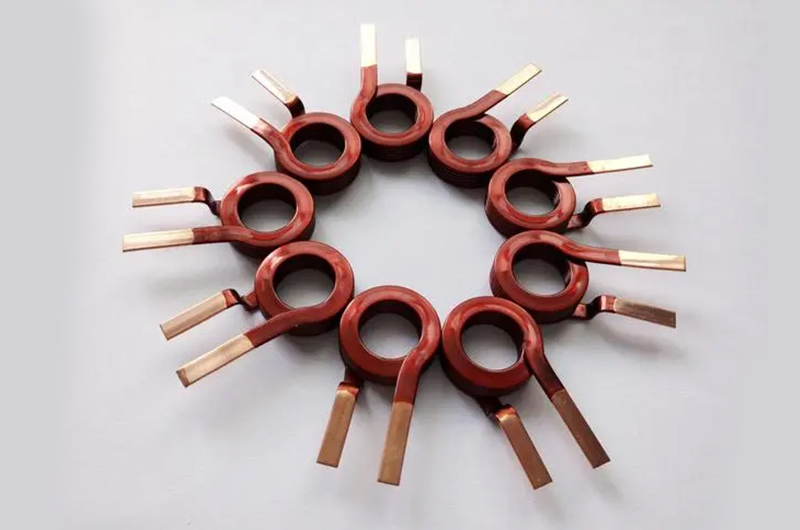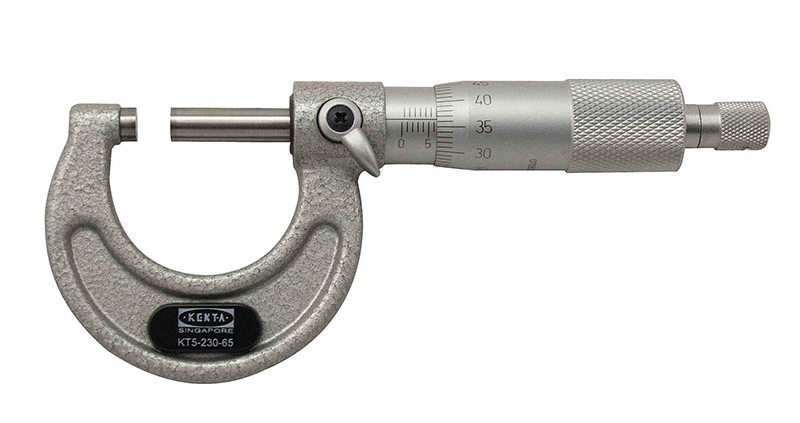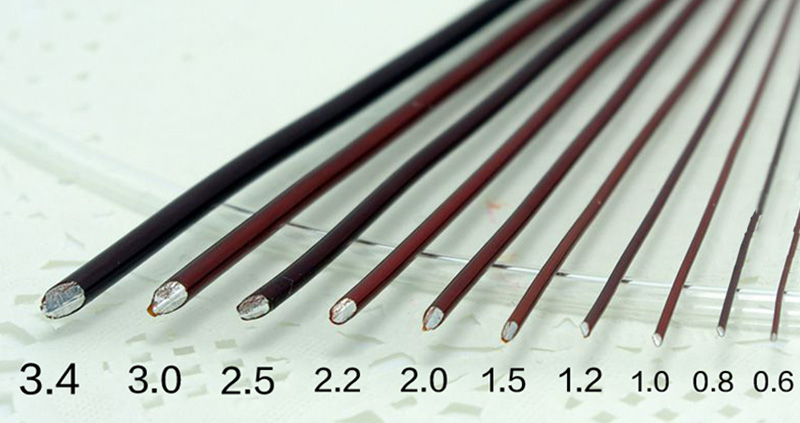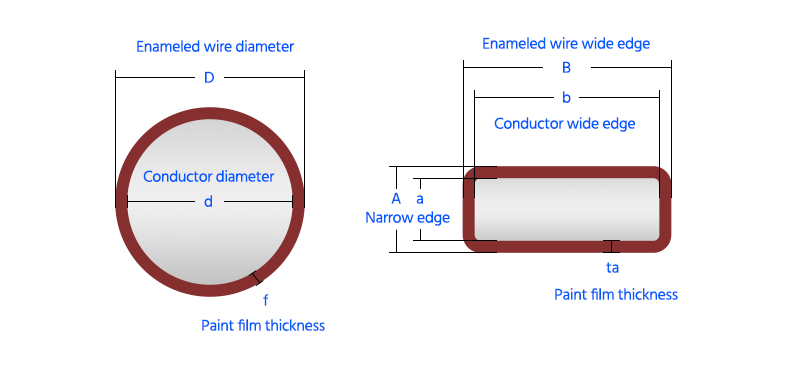Enamel Coating Thickness Measurement In-Depth
Updated : Feb. 20, 2024Enameled aluminum wire, as a crucial component in electrical devices, has its insulation coating thickness directly impacting electrical performance and reliability. Accurate measurement of the coating thickness is a key step in ensuring product quality. Below, we will provide a detailed overview of traditional methods for measuring coating thickness, as well as other more advanced measurement techniques.

Measurement Methods
The preparation for coating thickness measurement involves the use of a micrometer with an accuracy of 0.001mm, which is the primary tool for traditional enamel wire thickness measurement. To observe surface details of the coating, a projector or magnifying glass can be used, along with a specialized template to measure different corner radii (R).
Careful selection of auxiliary tools is crucial to ensure accurate and reliable size measurements. Finally, using the micrometer, measure the conductor diameter and enameled wire diameter to determine the coating thickness that meets the inspection standards.

Step One: Enameled Wire Diameter Measurement
Circular Enameled Wire Diameter (D):Measure at three evenly distributed points along the circumference of the sample at two positions spaced 1000mm apart.
Rectangular Enameled Wire Outer Dimensions:Using a perfectly straight sample, measure the dimensions of the narrow side (A) and wide side (B) at three positions separated by at least 100mm. Record the measurements. If the sample size is greater than the diameter of the micrometer measuring rod, measure at the middle and ends of the sample, taking the larger value as the measurement result for that location.

Step Two: Enameled Wire Paint Stripping
To proceed with the measurement of enamel thickness, a paint stripping process is essential. Different paint stripping methods are suitable for various scenarios, including blade scraping, centrifugal knife paint stripping, grinding wheel paint stripping, and the use of paint stripping agents. For detailed paint stripping methods, refer to the six skinning methods for enameled wire.
Step Three: Measurement of Conductor Diameter of Enameled Wire
Measurement of Conductor Diameter for Round Enameled Wire
For round enameled wire conductor diameter (d):at two positions spaced 1000mm apart, remove the enamel without damaging the conductor. At each position, perform measurements at three evenly distributed points along the circumference of the sample.
Measurement of Conductor Diameter for Rectangular Enameled Wire
Dimensions of Rectangular Enameled Wire Conductor: At the three positions mentioned in the previous measurements, remove the insulation without damaging the conductor and measure the narrow side (a) and wide side (b) of the flat conductor.
Radius of Rounded Corners for Rectangular Enameled Wire Conductor (R): Measure a section with a length not less than 200mm. Fill it with resin that does not affect the insulation, and the resin color should differ from the insulation enamel. After polishing a cross-section perpendicular to the sample axis, compare and measure it using a 20x magnifying glass or a projector with a special template.

Step Four: Calculation of Enameled Wire Insulation Thickness
Calculation of Insulation Thickness for Round Enameled Aluminum Wire
Obtain the arithmetic average of the six measurements at the two positions on the enameled wire to determine the measured diameter (D) of the enameled wire.
Obtain the arithmetic average of the six measurements at the two positions on the conductor to determine the measured diameter (d) of the conductor.
Calculate the insulation thickness (t) using the formula: t = D - d, where:
- t is the insulation thickness (mm),
- D is the outer diameter of the round enameled wire (mm),
- d is the diameter of the conductor of the round enameled wire (mm).
Calculation of Enameled Flat Aluminum Wire Insulation Thickness
Obtain the arithmetic average of the measurements at three positions on sides A and B of the flat enameled wire to determine the measured dimensions of the flat enameled wire.
Obtain the arithmetic average of the measurements at three positions on sides a and b of the conductor to determine the measured dimensions of the conductor of the flat enameled wire.
Calculate the insulation thickness for the narrow side (ta) using the formula: ta = A - a, where:
- ta is the insulation thickness for the narrow side (mm),
- A is the measured dimension of the narrow side of the flat enameled wire (mm),
- a is the dimension of the conductor on the narrow side of the flat enameled wire (mm).
Calculate the insulation thickness for the wide side (tb) using the formula: tb = B - b, where:
- tb is the insulation thickness for the wide side (mm),
- B is the measured dimension of the wide side of the flat enameled wire (mm),
- b is the dimension of the conductor on the wide side of the flat enameled wire (mm).
Other Portable Measurement Methods
X-ray Fluorescence Method
The X-ray fluorescence method is a non-contact technique for measuring paint thickness. It calculates the paint thickness by irradiating X-rays and detecting fluorescence signals. It is suitable for mass production, offering high accuracy and rapid testing.
Eddy Current Coating Thickness Gauge
The eddy current coating thickness gauge is a sensor-based device that measures paint thickness using the principle of induced currents. It is suitable for various shapes and sizes of enameled wire samples, and it is relatively easy to operate.
Microscopic Method
The microscopic method involves morphological analysis of the paint film to calculate its thickness. While the testing cost is relatively low, it requires intricate operation and professional skills.
Overview
When selecting a measurement method, it is essential to choose an appropriate approach based on production needs and specific circumstances. This ensures that the quality and performance of enameled wire meet the required standards. As a supplier of enameled aluminum wire, Chalco is committed to providing customers with products that meet performance standards. Every enameled wire is guaranteed to meet or exceed the specified quality requirements.
Chalco Enameled Aluminum Flat Wire Hot selling product
-
130/155 enameled aluminum flat wire
Temperature resistance: 130°C
Heat shock resistance: 150°C
-
180 enameled aluminum flat wire
Temperature resistance: 180°C
Heat shock resistance: 200°C
-
200 enameled aluminum flat wire
Temperature resistance: 200°C
Heat shock resistance: 220°C
-
Copper-Clad Enamelled Wire
Lightweight, excellent conductivity
Easy to process
-
Heavy Coating Enameled Wire
Base coat thickness: 0.5-0.8mm
Second coat thickness: 1.2mm
-
Extra-Large Enameled Flat Wire
Maximum dimensions: 3.5*35mm
Suitable for vertical winding
-
Extra Large Enamelled Round Wire
Maximum diameter: 3.0-15mm
Suitable for heavy winding on large spools
-
Solderable Enamel Wire
No need for paint removal
Can be directly soldered
-
Self-Adhesive Enamel Wire
Alcohol-based heat bonding
Provides a more compact winding
-
Arc-Resistant Enamel Wire
Excellent corona resistance
Outstanding dielectric performance
-
High-Temperature Resistant Wire
Voltage resistance: 5-12KV
The enamel film does not crack under 350℃ baking
-
Micro Enamel Wire
Minimum specification: 0.2*1mm
High slot filling rate




